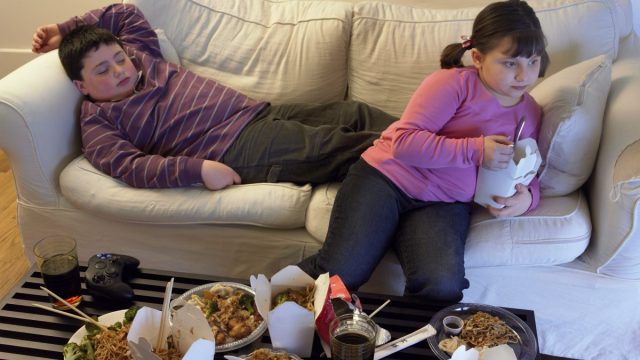This Is Why The Kids Are Fat

Childhood obesity has become a “crisis,” the media tells us. In fact, it has become a First Lady Issue, with Michelle Obama behind a federal push to micromanage school lunches across the nation (because clearly, if there’s one thing we need a federal government for, it’s dictating what’s on school lunch trays).
School bake sales are in the government’s crosshairs, as are things like soda and vending machines. The best way to help kids make better decisions about their diets is to not allow them to make any decisions at all, right?
But what if the real problem with childhood obesity wasn’t bake sales or school lunches or the candy machine in the school lobby? What if it was overzealous parents?
“Kids today have a lot less freedom than their parents did,” reads a sub-headline at Slate.
And that’s the problem:
Broad surveys show that childhood norms have shifted drastically over a generation (in 1971, for example, 80 percent of third-graders walked to school alone, but by 1990, only 9 percent did), and our survey of Slate readers confirms that trend. We asked, for example, when readers were allowed to walk 1 to 5 miles from home. For the cohort born in the 1940s, the majority answered second to third grade. By the time we get to the cohort born in the 1980s, the age shifts to fifth grade, and for the 1990s cohort, we are solidly in middle school. A similar trend shows up for a host of other issues, such as going to the playground alone and having to check in with parents when you are out for several hours. The shift in going out after dark is especially dramatic. Earlier cohorts were allowed out at night in middle school, but by the 1990s the norm is solidly high school.
Modern parents are much less likely to allow their children outdoors play time without supervision. That translates into less play time for children.
This is justified by the idea that we are living in more dangerous times. After all, don’t we all see the Amber Alerts? The news coverage of abductions? Sex predators? The thing is, we aren’t really living in more dangerous times.
“A child is no more likely to be abducted by a stranger today than he was in the 1970s, according to David Finkelhor, director of the Crimes Against Children Research Center,” reports Slate.
Back in March, Hanna Rosin had an excellent article for The Atlantic about this same topic. One area she addressed was the change in playground equipment. After some high-profile lawsuits and regulation changes back in the 1980’s, playgrounds were “transformed into sterile, boring places,” according to Rosin.
The safety crusaders took the fun out of playgrounds, and that means fewer kids interested in spending time at playgrounds. And, ironically, this move toward safety hasn’t actually accomplished much in terms of actual safety:
But the final irony is that our close attention to safety has not in fact made a tremendous difference in the number of accidents children have. According to the National Electronic Injury Surveillance System, which monitors hospital visits, the frequency of emergency-room visits related to playground equipment, including home equipment, in 1980 was 156,000, or one visit per 1,452 Americans. In 2012, it was 271,475, or one per 1,156 Americans. The number of deaths hasn’t changed much either. From 2001 through 2008, the Consumer Product Safety Commission reported 100 deaths associated with playground equipment—an average of 13 a year, or 10 fewer than were reported in 1980.
In fact, modern playground equipment may actually be promoting risky behavior among kids. “The advent of all these special surfaces for playgrounds has contributed very little, if anything at all, to the safety of children,” David Ball, a professor of risk management at Middlesex University in the U.K., told Rosin.” Ball notes that softer surfaces make kids think they won’t get hurt if they fall, prompting them to do things they wouldn’t have otherwise.
But lest we get too far down into the weeds, suffice it to say that modern society has gone so far overboard in the name of protecting children that we seem to have begun doing them harm. We’ve created an overweening nanny state filled with bureaucrats and their absurd regulations, and lawyers always ready to file a tort over what we might have written off in another age as just an accident.
We live in fear. We’re afraid of letting our kids alone time outdoors. Not just because they might be abducted or harmed by strangers, but maybe because we’re afraid our neighbors might call the police down on us for being irresponsible parents (yeah, it happens). It’s easier to let the kids stay indoors and play video games or watch Netflix. Why take the risk?
The side effect is that our children are less physically active and, to put it bluntly, they’re fatter. But instead of recognizing the problem – an overprotective society that won’t let kids be kids – we’re layering on more nanny-statism in the form of government controls on what our kids eat.
As so often happens, we’re trying to fix a problem caused by excessive government intervention with more government intervention.




